Shibuya Station
Shibuya Station 渋谷駅 | |
|---|---|
.jpg) The station's Hachiko exit in August 2015 | |
| Location |
Shibuya, Tokyo Japan |
| Coordinates | 35°39′31″N 139°42′05″E / 35.658514°N 139.70133°ECoordinates: 35°39′31″N 139°42′05″E / 35.658514°N 139.70133°E |
| Operated by | |
| Connections | Bus terminal |
| History | |
| Opened | 1885 |
| Location | |
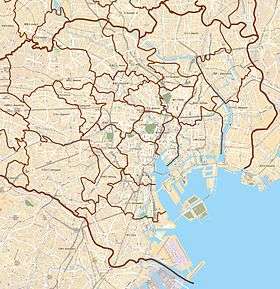 Shibuya Station Location within Special wards of Tokyo  Shibuya Station Shibuya Station (Japan) | |
Shibuya Station (渋谷駅 Shibuya-eki) is a railway station in Shibuya, Tokyo, Japan, operated jointly by East Japan Railway Company (JR East), Keio Corporation, Tokyu Corporation, and Tokyo Metro. With 2.4 million passengers on an average weekday in 2004, it is the fourth-busiest commuter rail station in Japan and the world (after Shinjuku, Ikebukuro, and Ōsaka / Umeda) handling a large amount of commuter traffic between the center city and suburbs to the south and west.[1]
Lines
JR East
- JA Saikyō Line / JSShōnan–Shinjuku Line (Yamanote Freight Line) - also used by Narita Express trains
- JYYamanote Line - unusual platform configuration, with both train lines on the same side (east) of the platforms
Private railways
- Keio Inokashira Line - terminus
- DTTokyu Den-en-toshi Line - through service with Tokyo Metro Hanzomon Line
- TYTokyu Toyoko Line - through service with Tokyo Metro Fukutoshin Line
Subways
- G Tokyo Metro Ginza Line - terminus
- Z Tokyo Metro Hanzomon Line - through service with Tokyu Den-en-toshi Line
- F Tokyo Metro Fukutoshin Line - through service with Tokyu Tōyoko Line
Note that the Tokyo Metro Hanzomon Line and Fukutoshin Line are directly connected (without passing through ticket gates), but they are not directly connected to the Ginza Line.
Station layout
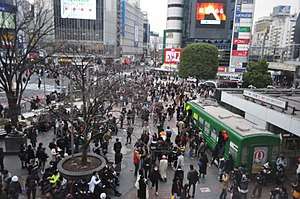
In 2013 and 2014, Shibuya station underwent major renovations as a part of a long-term site redevelopment plan.[2] While all rail and subway lines continued to operate, some station exits and entrances were subject to change. As of March 2013, the east side of the main station was transformed due to the provision of through train services between the Tokyu Toyoko Line and the Tokyo Metro Fukutoshin Line. While much of the main station building, previously housing the Tokyu department store, had been closed and was set for demolition, the west building of the Tokyu department store continued to operate as before. The Shibuya Hikarie building, also owned by the Tokyu Group, opened in 2012 and has featured department store retail, restaurants, and offices.
The Tokyo Metro Ginza Line, originally built and operated by a Tokyu keiretsu company, continues to use platforms on the third floor of the station building. The JR lines are on the second floor in a north-south orientation. The Tokyu Toyoko Line originally used parallel platforms on the second floor of the same building, but effective on 16 March 2013, the Toyoko Line moved underground to provide through service with the Tokyo Metro Fukutoshin Line. The Tokyo Metro Hanzomon Line and Tokyu Den-en-Toshi Line share platforms underground in a different part of the station. The Keio Inokashira Line uses platforms on the second floor of the Shibuya Mark City building to the west of the main station complex.
The main JR/Tokyu/Tokyo Metro complex has six exits. The Hachikō Exit (ハチ公口 Hachikō-guchi) on the west side, named for the nearby statue of the dog Hachikō, and adjacent to Shibuya's famous scramble crossing, is a particularly popular meeting spot. The Tamagawa Exit (玉川口 Tamagawa-guchi) on the west side leads to the Keiō Inokashira Line station.
On 17 November 2008, a mural by Tarō Okamoto, "The Myth of Tomorrow", depicting a human figure being hit by an atomic bomb, was unveiled in its new permanent location at the station, in the connecting passage to the Keio Inokashira Line entrance.
JR East
SBYJY20JA10JS19 Shibuya Station 渋谷駅 | |
|---|---|
| JR East station | |
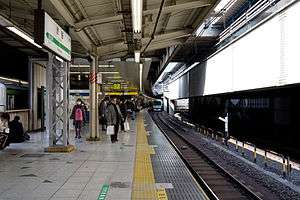 Yamanote Line platform, March 2010 | |
| Location |
1-1 Dogenzaka Itchōme, Shibuya, Tokyo Japan |
| Operated by |
|
| Line(s) |
|
| History | |
| Opened | 1885 |
| Traffic | |
| Passengers (FY2013) | 378,539 daily |
Platforms
The Yamanote Line is served by two side platforms with two tracks. The Saikyo Line and Shonan-Shinjuku Line is served by one island platform with two tracks. The Saikyo Line platform is located to the south of the Yamanote Line platforms, approximately 350 m away.[3]
| 1 | JY Yamanote Line | for Shinagawa, and Tokyo |
| 2 | JY Yamanote Line | for Shinjuku and Ikebukuro |
| 3 | JA Saikyō Line | for Shinjuku, Ōmiya, and Kawagoe |
| JS Shōnan-Shinjuku Line | for Shinjuku and Ōmiya (via the JU Takasaki Line) for Kumagaya, Takasaki, Maebashi (via the JU Utsunomiya Line) for Oyama, Utsunomiya | |
| 4 | JA Saikyō Line | for Ōsaki R Rinkai Line for Shin-Kiba |
| JS Shōnan-Shinjuku Line | for Yokohama and Ōfuna (via the JT Tōkaidō Line) for Odawara (via the JO Yokosuka Line) for Zushi | |
| ■ Ltd. Express Narita Express | for Tokyo and Narita Airport |
Adjacent stations
| « | Service | » | ||
|---|---|---|---|---|
| Yamanote Line JY20 | ||||
| Ebisu EBSJY21 |
- | Harajuku JY19 | ||
| Saikyō Line JA10 | ||||
| Ebisu EBSJA09 |
Commuter Rapid | Shinjuku SJKJA11 | ||
| Ebisu EBSJA09 |
Rapid | Shinjuku SJKJA11 | ||
| Ebisu EBSJA09 |
Local | Shinjuku SJKJA11 | ||
| Shōnan-Shinjuku Line JS19 | ||||
| Tokyo TYOJO19 Shinagawa SGWJO17 |
Narita Express | Shinjuku SJKJS20 | ||
| Ōsaki OSKJS17 |
Special Rapid | Shinjuku SJKJS20 | ||
| Ebisu EBSJS18 |
Rapid | Shinjuku SJKJS20 | ||
| Ebisu EBSJS18 |
Local | Shinjuku SJKJS20 | ||
Tokyo Metro/Tokyu
| Station layout | ||
|---|---|---|
| 3F Ginza Line platforms |
Side platform, doors will open on the left for boarding passengers only | |
| Platform 2 | → Ginza Line towards Asakusa (Omotesandō) → | |
| Platform 1 | ← Ginza Line termination track ← | |
| Side platform, doors will open on the left for alighting passengers only | ||
| 2F | Upper mezzanine | Ginza Line ticket barriers, ticket machines, station agent Passageways to JR and Keio Inokashira Line platforms |
| 1F | Street Level | Exit/Entrance Transfer between Ginza Line and Hanzomon Line/Fukutoshin Line/Tokyu stations |
| B1F | Transfer mezzanine | Staircases and elevators to lower mezzanine |
| B2F | Lower mezzanine | Hanzomon Line/Fukutoshin Line/Tokyu ticket barriers, ticket machines, station agent |
| B3F Hanzōmon Line Den-en-toshi Line platform |
Platform 2 | → Hanzōmon Line towards Oshiage (Omotesandō) → |
| Island platform, doors will open on the right | ||
| Platform 1 | ← Tōkyū Den-en-toshi Line towards Chūō-Rinkan (Ikejiri-Ōhashi) ← Hanzōmon Line termination track | |
| B4F | Transfer mezzanine | Transfer between Hanzōmon Line/Den-en-toshi Line and Fukutoshin Line/Tōyoko Line platforms |
| B5F Fukutoshin Line Tōyoko Line platforms |
Platform 6 | → Fukutoshin Line towards Wakōshi (Meiji-Jingūmae) → |
| Island platform, doors will open on the left/right | ||
| Platform 5 | → Fukutoshin Line towards Wakōshi (Meiji-Jingūmae) → | |
| Platform 4 | ← Tokyu Toyoko Line towards Yokohama (Daikan-yama) | |
| Island platform, doors will open on the left/right | ||
| Platform 3 | ← Tōkyū Tōyoko Line towards Yokohama (Daikan-yama) | |
Tokyu Den-en-toshi Line and Tokyo Metro Hanzomon Line
DT01 Z01 Shibuya Station 渋谷駅 | |
|---|---|
|
Tokyu (Den-en-toshi Line) Tokyo Metro (Hanzomon Line) station | |
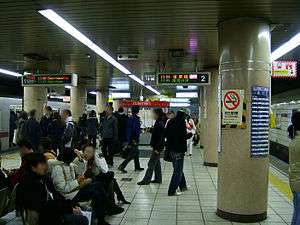 Tokyo Metro Station Platforms | |
| Location |
1-1 Dogenzaka Nichōme, Shibuya, Tokyo Japan |
| Operated by | |
| Line(s) | |
| Platforms | 1 island platform |
| Tracks | 2 |
| Other information | |
| Station code | DT01, Z-01 |
| History | |
| Opened | 1977 |
Platforms
On the third basement (B3F) level, a single underground island platform serves two tracks.
| 1 | DT Tokyu Den-en-toshi Line | for Futako-Tamagawa, Nagatsuta, and Chūō-Rinkan |
| 2 | Z Tokyo Metro Hanzomon Line | for Otemachi and Oshiage TS Tobu Skytree Line for Tōbu-Dōbutsu-Kōen TI Tobu Isesaki Line for Kuki TN Tobu Nikko Line for Minami-Kurihashi |
Adjacent stations
| « | Service | » | ||
|---|---|---|---|---|
| Tokyu Den-en-toshi Line DT01 | ||||
| Tokyo Metro Hanzomon Line Z01 | ||||
| Sangenjaya DT03 | Express | Omote-sando Z02 | ||
| Ikejiri-Ōhashi DT02 | Semi Express | Omote-sando Z02 | ||
| Ikejiri-Ōhashi DT02 | Local | Omote-sando Z02 | ||
Tokyu Toyoko Line and Tokyo Metro Fukutoshin Line
TY01 F16 Shibuya Station 渋谷駅 | |
|---|---|
|
Tokyu (Toyoko Line) Tokyo Metro (Fukutoshin Line) station | |
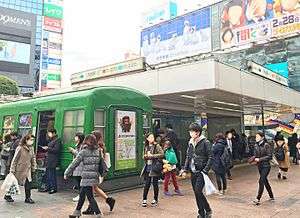 The Tokyu and Tokyo Metro Line Entrance in February 2016 | |
| Location |
1-1 Dogenzaka Nichōme, Shibuya, Tokyo Japan |
| Operated by | |
| Line(s) | |
| Platforms | 2 island platforms |
| Tracks | 4 |
| Other information | |
| Station code | TY01, F-16 |
| History | |
| Opened | 2008 |
Platforms
Two underground island platforms on the fifth basement (B5F) level serve four tracks.
| 3-4 | TY Tokyu Toyoko Line | for Jiyūgaoka, Yokohama Minatomirai Line for Motomachi-Chukagai |
| 5-6 | F Tokyo Metro Fukutoshin Line | for Shinjuku-sanchome, Ikebukuro, and Wakoshi TJ Tobu Tojo Line for Shinrinkōen Seibu Ikebukuro Line for Hannō |
Adjacent stations
| « | Service | » | ||
|---|---|---|---|---|
| Tokyu Toyoko Line TY01 | ||||
| Shinjuku-sanchome F13 (Fukutoshin Line) |
S-Train (weekends and national holidays) |
Jiyūgaoka TY07 | ||
| (Tokyo Metro Fukutoshin Line) | Limited Express | Naka-Meguro TY03 | ||
| Meiji-jingumae 'Harajuku' F15 (Fukutoshin Line) |
F Liner Limited Express | Naka-Meguro TY03 | ||
| (Tokyo Metro Fukutoshin Line) | Commuter Express | Naka-Meguro TY03 | ||
| (Tokyo Metro Fukutoshin Line) | Express | Naka-Meguro TY03 | ||
| (Tokyo Metro Fukutoshin Line) | Local | Daikanyama TY02 | ||
| Tokyo Metro Fukutoshin Line F16 | ||||
| Shinjuku-sanchome F13 | S-Train (weekends and national holidays) |
Jiyūgaoka TY07 (Toyoko Line) | ||
| Meiji-jingumae 'Harajuku' F15 | Express | (Tokyu Toyoko Line) | ||
| Meiji-jingumae 'Harajuku' F15 | F Liner Express | Naka-Meguro TY03 (Toyoko Line) | ||
| Shinjuku-sanchome F13 | Commuter Express | (Tokyu Toyoko Line) | ||
| Meiji-jingumae 'Harajuku' F15 | Local | (Tokyu Toyoko Line) | ||
Tokyo Metro Ginza Line
G01 Shibuya Station 渋谷駅 | |
|---|---|
| Tokyo Metro station | |
 A Ginza Line train arriving in Shibuya. Shibuya is the only place where the line runs above ground. | |
| Location |
1-1 Dogenzaka Itchōme, Shibuya, Tokyo Japan |
| Operated by | ■ Tokyo Metro |
| Line(s) | G Tokyo Metro Ginza Line |
| Platforms | 2 side platforms |
| Tracks | 2 |
| Connections | Bus terminal |
| Other information | |
| Station code | G-01 |
| History | |
| Opened | 1938 |
| Traffic | |
| Passengers (FY2013) | 212,136 daily |
Platforms
Two side platforms serve two tracks.
| 1 | G Tokyo Metro Ginza Line | Terminating services only |
| 2 | G Tokyo Metro Ginza Line | for Akasaka-mitsuke, Ginza, Ueno, and Asakusa |
Adjacent stations
|
 The Ginza Line platforms in 1977
The Ginza Line platforms in 1977
Keio Inokashira Line
 Shibuya Station 渋谷駅 | |
|---|---|
| Keio station | |
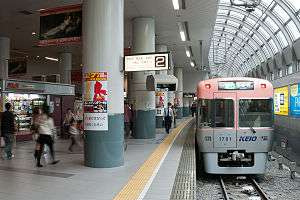 The Keio Inokashira Line platforms in November 2011 | |
| Location |
4-1 Dogenzaka Itchōme, Shibuya, Tokyo Japan |
| Operated by | ■ Keio Corporation |
| Line(s) | ■ Keio Inokashira Line |
| Tracks | 2 |
| Other information | |
| Station code | IN01 |
| History | |
| Opened | 1933 |
| Traffic | |
| Passengers (FY2013) | 730,849 daily |
Platforms
The Keio station consists of two bay platforms serving two tracks.[4]
| 1, 2 | ■ Keio Inokashira Line | for Shimo-Kitazawa, Meidaimae, Eifukuchō, and Kichijōji |
Adjacent stations
| « | Service | » | ||
|---|---|---|---|---|
| Keio Inokashira Line (IN01) | ||||
| Terminus | Express | Shimo-Kitazawa (IN05) | ||
| Terminus | Local | Shinsen (IN02) | ||
History
On 1 March 1885, Shibuya Station first opened as a stop on the Shinagawa Line, a predecessor of the present-day Yamanote Line.
The station was later expanded to accommodate the Tamagawa Railway (1907; closed 1969), the Toyoko Line (1927), and the Teito Shibuya Line (1 August 1933; now the Inokashira Line).[5]
Between 1925 and 1935, an Akita dog named Hachiko waited for his deceased owner, appearing at the station right when his train was due.
In 1938, the station added the Tōkyō Rapid Railway, which began through service with the Ginza Line in 1939 and formally merged in 1941.
In 1946, the infamous Shibuya incident, a gang fight involving hundreds of people, occurred in front of the station.
 In the early 1920s
In the early 1920s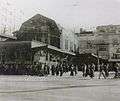 In 1951
In 1951 Circa 1960
Circa 1960
More recently, the station began servicing the Den-en-toshi Line (1977), the Hanzōmon Line (1978), and the Fukutoshin Line (2008).
Between December 2008 and March 2009, piezoelectric mats were installed at Shibuya Station as a small scale test.[6][7][8][9]
From 22 February 2013, station numbering was introduced on Keio lines, with Shibuya Station becoming "IN01".[10]
Former Toyoko Line station
 Shibuya Station 渋谷駅 | |
|---|---|
| Tokyu (Toyoko Line) station | |
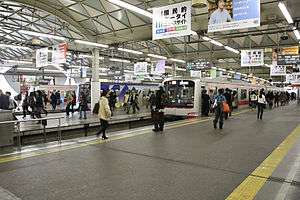 Former Tokyu Toyoko Line platforms in February 2009 | |
| Location |
2-24-1 Shibuya, Shibuya, Tokyo Japan |
| Operated by | Tokyu Corporation |
| Line(s) | Tokyu Toyoko Line |
| Tracks | 4 |
| Other information | |
| Station code | TY-01 |
| History | |
| Opened | 1927 |
| Closed | 15 March 2013 |
The former above-ground Tokyu Toyoko Line terminal station platforms were taken out of use after the last train service on 15 March 2013. From the start of the revised timetable on 16 March 2013, Toyoko Line services used the underground platforms 3-6 shared with Tokyo Metro Fukutoshin Line services.
Platforms
The station had four 8-car long bay platforms numbered 1 to 4, serving four tracks.
| 1-4 | ■ Tokyu Toyoko Line | for Naka-Meguro, Jiyūgaoka, Yokohama, (Minatomirai Line) Motomachi-Chūkagai |
Future developments
JR East is in the process of rebuilding the station, with reconstruction work starting in earnest in fiscal 2015.[3] When completed, the Yamanote Line will be served by an island platform instead of the current separated side platform arrangement, and the Saikyo Line platforms, currently approximately 350 m away, will be moved alongside the Yamanote Line platforms to make interchanging easier.[3]
Tokyu Corporation plans to develop a 47-story commercial building atop the relocated Toyoko Line platforms to the east of the station, which will become the tallest building in Shibuya upon its opening in 2019. Tokyu also plans to open a 16-story commercial/residential complex at the station in 2018, followed by a 35-story building on the site of the former Toyoko Line terminal in 2020.[11]
Passenger statistics
In fiscal 2013, the JR East station was used by 378,539 passengers daily (boarding passengers only), making it the fifth-busiest JR East station.[12] Over the same fiscal year, the Keio station was used by an average of 336,957 passengers daily (exiting and entering passengers), making it the busiest station on the Inokashira Line.[13] In fiscal 2013, the Tokyo Metro Ginza station was used by an average of 212,136 passengers daily and the Tokyo Metro Hanzōmon and Fukutoshin stations were used by an average of 731,184 passengers daily. Note that the latter statistics consider passengers who travel through Shibuya station on a through service as users of the station, even if they did not disembark at the station.[14] In fiscal 2013, the Tokyu Toyoko Line station was used by an average of 441,266 passengers daily and the Den-en-toshi Line station was used by an average of 665,645 passengers daily.[15] The daily passenger figures for each operator in previous years are as shown below.
| Fiscal year | JR East | Tokyu | Tokyo Metro | Keio | |
|---|---|---|---|---|---|
| Tōyoko Line | Den-en-toshi Line | ||||
| 1999 | 423,336[16] | 323,180[5] | |||
| 2000 | 428,165[17] | ||||
| 2005 | 423,884[18] | 412,237[19] | 631,481[19] | ||
| 2010 | 403,277[20] | 419,482[21] | 647,331[21] | 336,926[22] | |
| 2011 | 402,766[23] | 420,163[24] | 641,781[24] | 217,117[25] | 335,475[22] |
| 2012 | 412,009[26] | 435,994[27] | 656,867[27] | 226,644[28] | 344,972[13] |
| 2013 | 378,539[12] | 441,266[15] | 665,645[15] | 212,136[14] | 336,957[13] |
- Note that JR East figures are for boarding passengers only.
- Note that the Tokyo Metro figures are for the Ginza Line station only.
Surrounding area

Around the station is the commercial center of Shibuya. The Tokyu Department Store is connected to the east gate of the station and several other department stores are within walking distance.
- Shibuya Ward Office
- NHK Broadcasting Center
- NHK Hall
- Shibuya Mark City
- Shibuya 109
- Shibuya Hikarie
- Yoyogi Park
- Miyashita Park
The Shibuya River flows directly under the station, to the east and parallel to the JR tracks. Unlike most other Japanese department stores, the east block of Tokyu Department Store closed in 2013 and due for demolition as a part of the Shibuya Station redevelopment plan did not have basement retail space due to the river passing directly underneath. An escalator in the east block of the store was constructed over the river stops a few steps above floor level to make space for machinery underneath without the need for further excavation. Rivers are deemed public space under Japanese law, so building over one is normally illegal. It is not clear why this was allowed when the store buildings were first constructed in 1933.
See also
References
- ↑ JR East 891,460 , Tokyu 414,833+680,395 "Archived copy". Archived from the original on 2012-06-03. Retrieved 2012-10-04. , Tokyo Metro Hanzomon Line 472,123+258,609 "Archived copy". Archived from the original on 2008-06-22. Retrieved 2008-06-22. , Keio 343,697 "Archived copy". Archived from the original on 2008-03-03. Retrieved 2009-10-28. Totals 3,061,117 million
- ↑ "Urban Planning Proposal for Areas Surrounding Shibuya Station" (PDF). Tokyu Corporation. 2013-03-28. Retrieved 2014-03-19.
- 1 2 3 Nagata, Kazuaki (17 April 2014). "Shibuya Station to be rebuilt". The Japan Times Online (in Japanese). Japan: The Japan Times Ltd. p. 2. Retrieved 17 April 2014.
- ↑ Kawashima, Ryozo (April 2010). 日本の鉄道 中部ライン 全線・全駅・全配線 第1巻 東京駅―三鷹エリア [Railways of Japan - Chubu Line - Lines/Stations/Track plans - Vol 1 Tokyo Station - Mitaka Area]. Japan: Kodansha. p. 10. ISBN 978-4-06-270061-0.
- 1 2 Terada, Hirokazu (July 2002). データブック日本の私鉄 [Databook: Japan's Private Railways]. Japan: Neko Publishing. p. 205. ISBN 4-87366-874-3.
- ↑ "Power-Generating Floors Offer New Source of Clean Energy". Trends in Japan. Web Japan. January 2010. Retrieved 2011-08-25.
- ↑ Skjoldan, Lasse (2009-01-29). "Foot Powering Tokyo Train Station". News and Opinions. Celsias. Archived from the original on 2011-10-05. Retrieved 2011-08-25.
- ↑ Fermoso, Jose (2008-12-17). "Power Generating Floor in Train Stations Light Up Holiday Displays". Wired – Gadget Lab. Condé Nast Digital. Retrieved 2011-08-26.
- ↑ Keferl, Michael (2009-07-08). "Electricity-Generating Flooring Gets Tokyo Test". CScout. Archived from the original on 2011-06-30. Retrieved 2011-08-25.
- ↑ 京王線・井の頭線全駅で「駅ナンバリング」を導入します。 [Station numbering to be introduced on Keio Line and Inokashira Line] (pdf). News release (in Japanese). Keio Corporation. 2013-01-18. Retrieved 2013-02-23.
- ↑ "Rail operator leads Shibuya renewal projects". Nikkei Asian Review. 5 March 2016. Retrieved 6 May 2016.
- 1 2 各駅の乗車人員 (2013年度) [Station passenger figures (Fiscal 2013)] (in Japanese). Japan: East Japan Railway Company. Retrieved 31 August 2014.
- 1 2 3 1日の駅別乗降人員 [Average daily station usage figures] (in Japanese). Japan: Keio Corporation. 2013. Retrieved 31 August 2014.
- 1 2 各駅の乗降人員ランキング [Station usage ranking] (in Japanese). Tokyo Metro. Retrieved 31 August 2014.
- 1 2 3 2013年度乗降人員 [2013 Station passenger figures] (in Japanese). Japan: Tokyū Corporation. 4 June 2014. Retrieved 2 September 2014.
- ↑ 各駅の乗車人員 (1999年度) [Station passenger figures (Fiscal 1999)] (in Japanese). Japan: East Japan Railway Company. Retrieved 23 February 2013.
- ↑ 各駅の乗車人員 (2000年度) [Station passenger figures (Fiscal 2000)] (in Japanese). Japan: East Japan Railway Company. Retrieved 23 February 2013.
- ↑ 各駅の乗車人員 (2005年度) [Station passenger figures (Fiscal 2005)] (in Japanese). Japan: East Japan Railway Company. Retrieved 23 February 2013.
- 1 2 2005年度乗降人員 [2005 Station passenger figures] (in Japanese). Japan: Tokyū Corporation. 19 May 2006. Retrieved 2 September 2014.
- ↑ 各駅の乗車人員 (2010年度) [Station passenger figures (Fiscal 2010)] (in Japanese). Japan: East Japan Railway Company. Retrieved 23 February 2013.
- 1 2 2010年度乗降人員 [2010 Station passenger figures] (in Japanese). Japan: Tokyū Corporation. 19 May 2011. Retrieved 2 September 2014.
- 1 2 1日の駅別乗降人員 [Average daily station usage figures] (in Japanese). Japan: Keio Corporation. 2013. Retrieved 23 February 2013.
- ↑ 各駅の乗車人員 (2011年度) [Station passenger figures (Fiscal 2011)] (in Japanese). Japan: East Japan Railway Company. Retrieved 2 July 2013.
- 1 2 2011年度乗降人員 [2011 Station passenger figures] (in Japanese). Japan: Tokyū Corporation. 15 May 2012. Retrieved 2 September 2014.
- ↑ 駅別乗降人員順位表(2011年度1日平均) [Station passenger figures (Fiscal 2011)] (in Japanese). Japan: Tokyo Metro. Retrieved 23 February 2013.
- ↑ 各駅の乗車人員 (2012年度) [Station passenger figures (Fiscal 2012)] (in Japanese). Japan: East Japan Railway Company. Retrieved 31 August 2014.
- 1 2 2012年度乗降人員 [2012 Station passenger figures] (in Japanese). Japan: Tokyū Corporation. 29 May 2013. Retrieved 2 September 2014.
- ↑ 各駅の乗降人員ランキング (2012年) [Station usage ranking (2012)] (in Japanese). Tokyo Metro. Retrieved 31 August 2014.
External links
| Wikimedia Commons has media related to Shibuya Station. |
- Shibuya Station information (JR East) (in Japanese)
- Shibuya Station information (Tokyo Metro) (in Japanese)
- Shibuya Station information (Tokyu) (in Japanese)
- Shibuya Station information (Keio) (in Japanese)